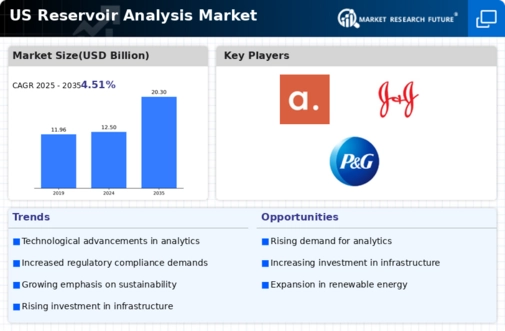Increased Demand for Water Resources
The growing demand for water resources in the United States is a primary driver of the reservoir analysis market. As urbanization and population growth continue, the need for efficient water management becomes critical. This trend is reflected in the increasing investments in reservoir infrastructure, which reached approximately $10 billion in 2024. The reservoir analysis market plays a vital role in optimizing water storage and distribution, ensuring that municipalities can meet the needs of their residents. Furthermore, the emphasis on sustainable water practices is likely to propel the adoption of advanced reservoir analysis technologies, which can enhance water conservation efforts and improve overall resource management.
Focus on Environmental Sustainability
The emphasis on environmental sustainability is reshaping the reservoir analysis market. As climate change concerns escalate, there is a growing need for effective water management strategies that minimize ecological impact. The reservoir analysis market is responding by developing solutions that promote sustainable practices, such as optimizing water usage and enhancing ecosystem health. This shift is supported by federal initiatives aimed at protecting water resources, which could lead to a 20% increase in funding for sustainable water projects by 2027. Consequently, the demand for reservoir analysis services that align with sustainability goals is likely to rise, driving innovation and growth in the market.
Integration of Advanced Data Analytics
The integration of advanced data analytics into the reservoir analysis market is transforming how water resources are managed. By leveraging big data and machine learning algorithms, stakeholders can gain deeper insights into reservoir performance and water quality. This shift is evidenced by a projected growth rate of 15% in the adoption of data-driven solutions within the industry by 2026. The reservoir analysis market is increasingly utilizing predictive analytics to forecast water demand and optimize reservoir operations, thereby reducing costs and improving efficiency. As organizations seek to harness the power of data, the demand for sophisticated analytical tools is expected to rise, further driving market growth.
Investment in Infrastructure Development
Investment in infrastructure development is a significant driver of the reservoir analysis market. The U.S. government has allocated substantial funding for water infrastructure projects, with an estimated $30 billion earmarked for upgrades and maintenance in 2025. This influx of capital is likely to enhance the capabilities of the reservoir analysis market, as new technologies and methodologies are implemented to improve water management. Additionally, the focus on aging infrastructure necessitates comprehensive reservoir assessments to ensure safety and efficiency. As these investments materialize, the demand for reservoir analysis services is expected to increase, creating opportunities for growth within the market.
Technological Innovations in Monitoring Systems
Technological innovations in monitoring systems are significantly influencing the reservoir analysis market. The advent of IoT devices and remote sensing technologies has enabled real-time monitoring of reservoir conditions, enhancing data accuracy and decision-making processes. The reservoir analysis market is witnessing a surge in the adoption of these technologies, with a projected market growth of 12% annually through 2025. These innovations facilitate better management of water resources, allowing for timely interventions and improved operational efficiency. As stakeholders increasingly recognize the value of advanced monitoring systems, the demand for reservoir analysis solutions that incorporate these technologies is expected to expand.

















Leave a Comment